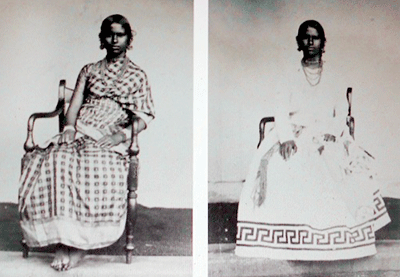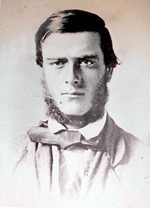
Please Share your Email if you Wish to Receive the Golden Tips & Tales Newsletter from History of Ceylon Tea Website
(Originally appeared in the Sunday Times 20th August 2017)

Photos from the book of the woman who it was speculated was Taylor’s partner
This 254-page book about the history of Ceylon tea was sent to me as an email attachment to download and read on a screen, in the fashion of those who use devices to read, instead of being able to hold the actual book in one’s hand. The disadvantage of this screen version of the book, certainly for a reviewer and I suspect for a regular reader too, is not being able to judge the worth and heft of a volume and flick through pages to select and underline choice bits at random.
… So for a preliminary insight into the book I had to rely on the Contents Page. This promises chapters covering the familiar ground to fans of this country’s tea such as: The Rise and Fall of King Coffee; Transition to Tea; Globalising Ceylon Tea; A Planter’s Life; Ties to Home, etc., concluding with the dour chapter title, The Scottish Effect.
It was only when I looked at the list of illustrations that I became intrigued and recognised the vast range of the authors’ research. One photo caption reads thus: “‘Certainly I’ll never marry a black,’”a quote from a letter by the book’s hero, James Taylor, under two photos from Taylor’s own photo album. The authors claim the photos are of the Tamil girl believed to be Taylor’s partner. I scrolled down immediately to Page 144 where details of Taylor’s sex life are revealed, even if derived from speculation.
…The authors cite a contemporary newspaper report of Taylor’s will as saying that funds were to be left to the “mother of his children.” But since Taylor was unmarried, this suggests either an actual or anticipated fruitful liaison with a female partner. However, the authors are adamant that Taylor had children as they assert: “What is incontrovertible is that Taylor had children and a native partner.”
…After this astounding revelation, the authors confess to being unable to trace any descendants of the supposed children, dismissing claims by some purported descendants as “their genealogy indicates instead that they are connected to two other Taylor brothers in Ceylon at the time: John and William Taylor who worked on the Wanarajah and Darawella estates.”
…Who knew Taylor had two brothers in Ceylon? Did he? The secret aspect of Taylor’s private life, drawn from the text below a photo caption, made me scroll back to the beginning of the book to see what other new information about Taylor, tea and empire, the authors have found.
…The four pages of acknowledgements, where Anselm Perera of Mlesna Tea is especially thanked, includes historians, librarians and even the authors’ driver, are given as evidence of their thorough research both in archives and in Sri Lanka. There are dozens of footnotes at the end of each chapter and the bibliography extends over 17 pages, listing scores of sources and books, including “The Growing Years” which I wrote in 2004 commemorating 150 years of The Planters’ Association of Ceylon. This made me realise before reading the book that it purports to be a magisterial volume.
…The authors wrote this book after seeing the correspondence of James Taylor, stating: “These collected sources are by far the richest archive we have come across for a 19th century migrant of humble origin from Scotland.” They claim proudly that: “this book is the first large-scale study of James Taylor and is the only one to use his extant correspondence from beginning to end.”
The first known photograph of James Taylor

The first known photograph of James Taylor
…One could almost accuse the authors of name dropping when they include names of hundreds of people as sources; perhaps to give weight to the book’s credentials as the definitive version of Taylor’s life and Ceylon’s tea. But never mind the footnotes, this is a story fascinating in all its detail.
Taylor’s early life in Scotland is rigorously dissected so that his later life – and regular letter writing – is seen in perspective, observing that Taylor “emerges as a disgruntled and sullen teenager.” They add that:“a mix of frustration but acceptance of his lot would continue throughout his life.”
… The authors run through the growing of coffee in Ceylon citing its success on the influence of Britons who had planted in Jamaica, and that Tamils from India “took work on the estates that Sinhalese were reluctant to do.” They note that coffee was still thriving in 1875 when there were: “1,215 plantations in Ceylon with an estimated extent of 270,000 acres. Seven hundred and fifty British managers and 200,000 Indian Tamils and their families were employed.” At that time only 560 acres were devoted to tea. It was from 1879 that the blight that destroyed coffee took its devastating hold.
…Taylor’s natural skill as an agronomist led to him experimenting with different crops on different fields, which resulted in the now-famous first planting of tea at Loolecondera. The “Transition to Tea” chapter covers much of which is familiar, but also records Taylor’s frustration at being passed over as an official trade commissioner to India, something which, the authors suggest, motivated him to make a name for himself by being the first to plant tea. The book surprisingly reveals that Taylor’s first clearing of land and planting of tea in 1867 “completely failed to grow.” He is rightly recognised, however, as the pioneer planter of tea in Ceylon.
…The growth and popularity of Ceylon tea is covered extensively before the book veers off to recount a planter’s life. In Taylor’s case this meant combating the natural elements, snakes and disease and tending (and later neglecting) his beard as well as building an impressive bungalow. His poor financial situation is probed as is his social life, including visits to and by other planters and their drinking habits. The authors quote a letter from Taylor musing that “heat must have dried up or melted my bump of amativeness for I don’t care a penny for ladies.”
…It was in another letter that he stated: “I’ll never marry a black and am not sure if a white would suit…” However, in the chapter on “Cross-Cultural Contact” we learn that Taylor was keeping a written track of the menstrual cycles of a girl called Paarvathy who “ran off Sept 25th 1872” and suggests that the reference to Paarvathy’s sister (born in May 1865) may have been to “his daughter.” It adds enough spice to this story of tea and planters to keep the reader engrossed. While Taylor’s father repeatedly urged him to return home to Scotland to marry, he resisted the idea.
…His death is covered in the chapter “Triumph and Tears” and here the authors speculate on how he died, doubting that it was through the stated dysentery, coincidentally occurring a few days after he had been dismissed following 40 years of service. Surprisingly they don’t suggest it was murder (although they report one attempt on his life), dismiss suicide, and plump for “a broken heart.”
… The book ends with a chapter delving into the Scottish influence in Ceylon, noting it was once called a Scottish colony. It includes a chart showing the family trees of the related Taylor, Moir and Stiven families of Scotland. Curiously, the aforementioned William Taylor is shown as James’ half-brother and there is no mention of John Taylor whom the authors claim was another brother.
Since this book is published in England by the University of Manchester, its contribution to international appreciation of the history of Ceylon tea is significant. It will have greater impact in promoting Ceylon tea worldwide than the local commemorations of the current sesquicentenary. If you ever want to buy a book on Ceylon tea, it’s doubtful you would find one as intriguing and detailed as this.